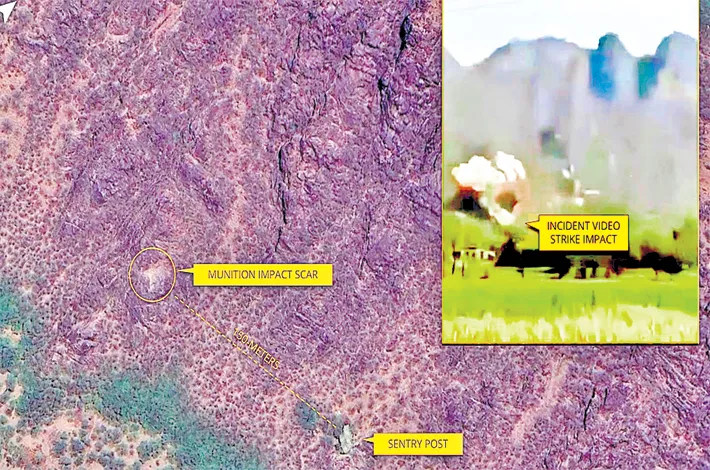Was Pakistan’s Kirana Hills damaged?
25-07-2025 12:00:00 AM

Was the damage done?
- Unverified satellite images on internet raised speculation about India’s recent military actions near Pakistan’s Kirana Hills, believed to house critical nuclear infrastructure.
- The images show damage to a military outpost in the region and repairs at Pakistan’s Sargodha Air Base, located less than 50 kilometers away from Kirana Hills.
- A prominent military commentator emphasized the BrahMos missile’s ability to destroy a fortified command and control bunker at Noor Khan Airbase.
- Air Marshal AK Bharti has denied any Indian strikes on Kirana Hills, claiming the Indian Air Force was unaware of nuclear facilities in the area.
- However, the proximity of the Sargodha Air Base, a confirmed target in retaliatory strikes has fuelled speculation about the true extent of the operation.
Fresh satellite images circulating on the internet have ignited speculation about India’s recent military actions near Pakistan’s Kirana Hills, a site believed to house critical nuclear infrastructure. The images show damage to a military outpost in the region and repairs at Pakistan’s Sargodha Air Base, located less than 50 kilometers away from Kirana Hills. The images, though unverified, depict possible evidence of a precision strike near Kirana Hills, raising questions over whether India deliberately targeted an area close to Pakistan’s nuclear facilities to send a strategic message.
Air Marshal AK Bharti has denied any Indian strikes on Kirana Hills, claiming the Indian Air Force was unaware of nuclear facilities in the area. However, the proximity of the Sargodha Air Base, a confirmed target in India’s retaliatory strikes following cross-border exchanges, has fuelled speculation about the true extent of the operation. The strike, described as a “warning shot,” was executed with BrahMos supersonic cruise missiles, achieving a 100% interception rate against three Pakistani tactical ballistic missiles fired in retaliation during the Operation Sindoor.
An ex-serviceman and prominent Indian military commentator revealed that India’s S-400 air defense system successfully neutralized the incoming missiles. He said that the Kirana Hills strike, deliberately aimed slightly away from the tunnel entrances, was intended to demonstrate India’s capability to penetrate Pakistan’s strategic sites with pinpoint accuracy. He also emphasized the BrahMos missile’s ability to navigate a 45 cm square air vent to destroy a fortified command and control bunker at Noor Khan airbase.
The Noor Khan facility, a critical hub for Pakistan’s air operations and nuclear command authority, was reportedly incapacitated, with satellite communications disrupted and air operations halted. The bunker, built by General Electric at a cost of $500 million, was designed to withstand a tactical nuclear hit and was EMP-protected, underscoring the significance of India’s strike.
Another retired Major General emphasized that India’s strikes aimed to disable Pakistan’s air assets and signal severe consequences for further aggression. He said that though the Indian armed forces targeted 11 sites, whether we hit nuclear facilities is unclear as military commanders avoided confirming it, noting the difficulty in distinguishing conventional and nuclear assets in a war zone. He referenced an existing agreement between nuclear-armed nations to avoid targeting nuclear installations but highlighted the ambiguity in such scenarios. The whole episode also raised a critical question: Who controls Pakistan’s nuclear arsenal? A former diplomat, pointed out that while India’s nuclear facilities are under government control, Pakistan’s chain of command remains opaque. She suggested that Pakistan’s role as a Chinese proxy state complicates the equation. She warned that unsecured nuclear assets could fall into the hands of “jihadis,” posing a global security threat.
Pakistani sources however dismissed claims about Kirana Hills, asserting the site has been non-operational since 1985. They questioned why Pakistan did not respond militarily, suggesting the strike’s proximity to nuclear tunnels prompted Islamabad to seek U.S. intervention to de-escalate. “If India attacks our nuclear site, why would we attack in the morning after requesting American help to stop the war?” a Pakistani military official said, sidestepping India’s claims of precision and dominance.
The International Atomic Energy Agency previously issued a clarification regarding the Kirana site, adding weight to India’s strategic ambiguity. An Indian security expert challenged Pakistan to provide evidence of any successful counterstrikes, pointing to the lack of damage at Noor Khan or other strategic sites like Shahbaz Air Base. He asked why the Pakistani government hasnot denied the hit on Kirana and cited global geo-intelligence reports and satellite imagery as undeniable proof. The exchange highlighted tensions over Pakistan’s military response, with Indian commentators questioning why Islamabad relied on diplomatic channels rather than demonstrating military competence. Allegations of ineffective Pakistani PL-15 missiles and damaged infrastructure at Shahbaz Air Base further fueled the debate.
As both sides traded barbs, the discussion underscored the precarious balance of power in the region, with India asserting its technological edge and Pakistan grappling with the implications of a precise, non-escalatory strike. The incident serves as a stark reminder of the volatile dynamics surrounding nuclear capabilities in South Asia.








